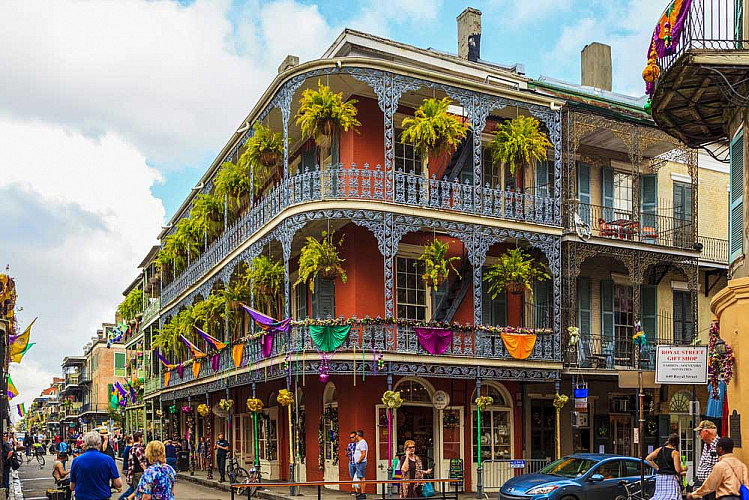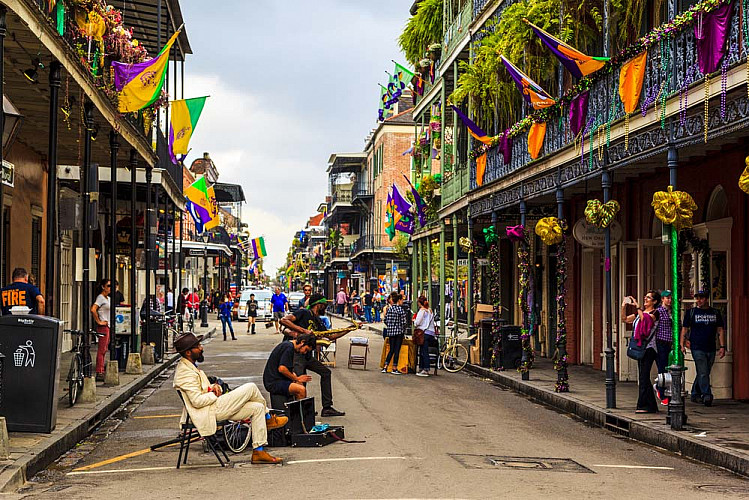Chitra Banerjee Divakaruni Spends A Day in Literary New Orleans
New Orleans! For years the words had conjured up visions of gracious Southern living, the irrepressible sounds of jazz, delicious Creole foods such as shrimp étouffée, jambalaya, king cake and the wild festivities of Mardi Gras. But for me, what was most enticing about New Orleans was its plethora of literary shrines, because it has been home and inspiration to many celebrated writers. So when I had an opportunity to visit, I was filled with excitement, delight and hope that perhaps something in my visit would spark off ideas for a new novel!
New Orleans was everything I had envisioned and a lot more as well. Hit hard in 2005 by Hurricane Katrina, which caused extensive property damage and many deaths, this spirited metropolis has now bounced back and is welcoming visitors with open arms. And tourists are responding with great enthusiasm! When I toured the historic French Quarter, which some would call the heart of New Orleans, during the December holidays, the colourful and jostling crowds reminded me of the teeming streets of my birth-city, Kolkata. Chris Rose, author of 1 Dead in Attic, writes about New Orleans: ‘We dance even if there’s no radio. We drink at funerals. We talk too much and laugh too loud and live too large and, frankly, we’re suspicious of others who don’t.” I was ready to explore and discover how far this was true!
I began my day at Jackson Square, located at the centre of the French Quarter and dominated by a large equestrian statue of former US President Andrew Jackson. The French influence is clear in the structure of this park, in its geometric pathways and clearly delineated flower beds. Armed with a large steaming café au lait and a beignet, the fried and sugared doughnut the city is famed for, I wandered through the square, admiring the street musicians, painters and mimes that peppered the pavements all around. I stopped for a little while on the banks of the Mississippi, watching the steamboats make their stately way up and down the river. I recalled that for many years Mark Twain piloted similar boats and wrote about it in his memoir Life on the Mississippi. Perhaps he had looked out from his steamboat at the very spot where I was standing! A food aficionado, Twain wrote: ‘New Orleans food is as delicious as the less criminal forms of sin.’ Biting into my delicious beignet, I agreed.
Next, I stopped to admire the venerable St Louis Cathedral, the oldest in North America and the city’s centre of Catholic worship for the last 280 years. Its triple black spires and white facade, looming benignly over Jackson Square, are considered famous landmarks. But of greater interest to me was Pirates Alley around the corner, where Faulkner House is located. In the 1920s, William Faulkner, the prize-winning author of The Sound and the Fury, lived in a room in this townhome and, as legend has it, was up to all kinds of drunken bohemian mischief here. The current owners, Joe DeSalvo and Rosemary Stand, have lovingly converted the first floor into a premier bookstore titled, as you might expect, The Faulkner Bookstore.
Wandering in, I touched the doorknob with veneration, thinking that perhaps Faulkner had opened this same door many times. Maybe some of his touch — and talent — would rub off on me! Joe and Rosemary say that Faulkner’s spirit is supposed to still visit the house — inexplicably, from time to time, guests have suddenly smelled the aroma of pipe tobacco, which Faulkner used. (I sniffed hard, but alas, smelled nothing!)
Tales of Faulkner’s spirit’s visitation, though, did not surprise me. New Orleans has officially been declared America’s most haunted city. There are haunted houses and cemeteries galore! The city also abounds in voodoo museums and shops. I peeked into one of the more famous shops, Reverend Zombie’s House of Voodoo, and saw a fascinating array of dolls, masks, potions, oils, altars and ‘gris-gris’ bags (inside which are lucky charms).
Even today, there are voodoo temples, most famously the Voodoo Spiritual Temple on the edge of the French Quarter, where the current-day voodoo ‘queen’ of New Orleans, Priestess Miriam, performs rituals regularly. The spirit of Marie Laveau, New Orleans’ most famous voodoo priestess, it is said, haunts her above-ground tomb in the St Louis cemetery and appears, at times, to the worthy! Famous in fiction as well, it has an empty tomb marked Louis, where one of the vampires of Anne Rice’s Vampire Chronicles was often to be found.
Instead of visiting the cemetery, I decided to visit some of the venues from the novels of Anne Rice, whom you might recognise as the writer of the deliciously frightening and intriguing Interview with the Vampire, and a host of other celebrated horror bestsellers. Rice was born in New Orleans, lived here for many years and has set many of her novels here. Going through the streets of the French Quarter, I stumbled upon several important spots related to them. Particularly eye-catching was Royal Street: its beautiful old red-brick houses with long, wrought-iron balconies hung with flowers and ferns and were decorated with stone sculptures. Several scenes from the movie of Interview with the Vampire were shot on this street, which was made to look a century older by having mud poured over the paved road surfaces! Along with several other tourists, I spent some time admiring Gallier House, a beautiful historic home with aquamarine wrought-iron balconies, now a restored museum on Royal Street, which was Anne Rice’s inspiration for the home of the vampire, Lestat.
Of special interest to me as I wandered around Royal Street was Hotel Monteleone. Not only did Rice spend some time in this stately white structure with colourful flags fluttering from its facade, the hotel is also known for many other famous literary patrons, such as Ernest Hemingway, Faulkner, Tennessee Williams, Eudora Welty, and more recently, John Grisham, who set his novel, Pelican Brief, in this city. There is an impressive window display of books that were supposedly written in this hotel, and inside, for weary tourists, there is a carousel bar that rotates slowly as we slake our thirst!
Among stories that are set in New Orleans, one of my personal favourites is Williams’ play, A Streetcar Named Desire. There was actually a streetcar-line in the city with that evocative name, and though streetcars are gone from most of New Orleans, the distinctive green-and-red vehicles can still be seen along one particular line, the St Charles, offering a wonderful and leisurely way of seeing the city.
New Orleans has embraced Williams as its most famous writer and has named its annual literary festival after him. On the last day, I am told, there is a shouting contest, re-enacting the famous scene from A Streetcar Named Desire, where the hero, Stanley, shouts out his beloved Stella’s name! By now it was getting late in the day, time for dinner. I decided to step into another literary landmark, Antoine’s, which is just off Royal Street. Author Frances Parkinson Keyes, who set many of her books in Louisiana, located her most successful murder mystery, Dinner at Antoine’s, in this restaurant, which has been around since 1840.
Though rather pricey, the restaurant was well worth it because of its beautiful old-world atmosphere, which could have been something out of Gone with the Wind. Once again, a visitor would find beautiful white wrought-iron grille-work on the balcony. Chandeliers twinkled in all the rooms, and delicious French Creole dishes were served on white and blue platters stamped with the restaurant’s crest. The fish and crab dishes were particularly fine, and the dessert, omelette Alaska Antoine, recommended by my guidebook, was an impressive affair — large enough for two, filled with vanilla ice cream, with pound cake on the bottom and egg-white meringue on top — and flambéed at the table. It delighted my Bengali dessert-loving heart and was the perfect decadent ending to my meal.
But my day of literary discovery was not yet complete. I made my way across the night and the increasingly raucous French Quarter. I crossed Bourbon Street, the infamous party road with its many bars and strip clubs. Drinking on the streets is legal in New Orleans and so I passed several revellers with their bottles held high. Finally, I reached the historic Preservation Hall Jazz Band auditorium, where I was going to catch a late-night performance.
Jazz is a huge part of New Orleans life and history. The city has harboured great musicians such as Louis Armstrong and Jelly Roll Morton, about whom books have been written. The musical tradition that they made famous all over the United States, even the world, continues to this day, in the tiny, dimly lit auditorium. Two books that I’ve enjoyed about jazz in New Orleans are Michael Ondaatje’s poetic Coming Through Slaughter, and Ishmael Reed’s experimental Mumbo Jumbo. In both novels, real musicians make an appearance alongside mythical ones, and the musical soul of the city lives vibrantly in them both.
“New Orleans is the only place I know of where you ask a little kid what he wants to be and instead of saying, ‘I want to be a policeman’ or ‘I want to be a fireman’, he says, ‘I want to be a musician’,” says Alan Jaffe, jazz musician and founder of Preservation Hall. Perhaps one of my future novels will be about such a kid!
I stood that night in the midst of a packed crowd in the small auditorium where the Preservation Hall Jazz Band dedicatedly performs several times every week of the year. I listened to an old African-American musician drawing out the notes on his saxophone, at once sad and soul-stirring. And then the trombone and drums came on, and I, along with everyone else, rocked and clapped and stamped my feet, feeling the spirit of New Orleans, knowing that I would carry it with me even after I left the city.
About the author:
Chitra Banerjee Divakaruni is the author of Before We Visit The Goddess and The Palace of Illusions. She lives in Houston with her husband and two sons.
Related posts from Verve:
Verve Trending
Sorry. No data so far.
us on Facebook to stay updated with the latest trends







